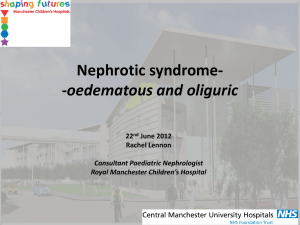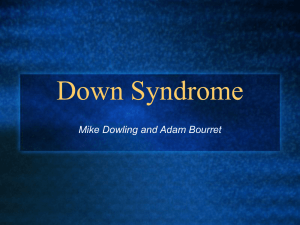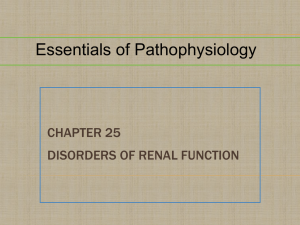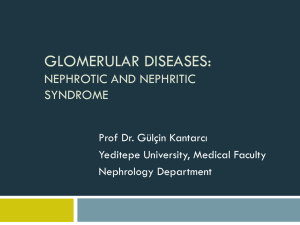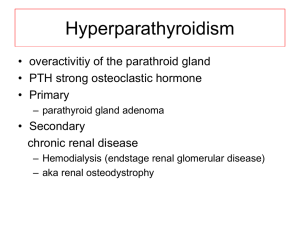Post-infectious glomerulonephritis
advertisement
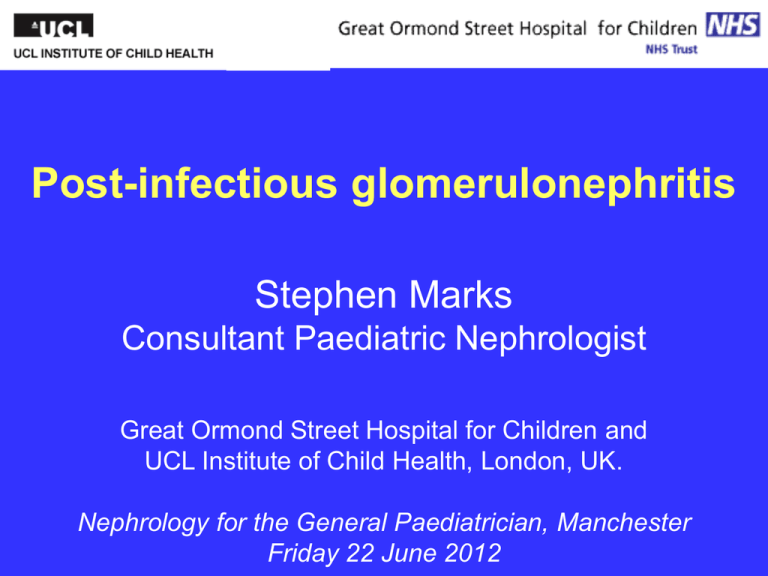
Post-infectious glomerulonephritis Stephen Marks Consultant Paediatric Nephrologist Great Ormond Street Hospital for Children and UCL Institute of Child Health, London, UK. Nephrology for the General Paediatrician, Manchester Friday 22 June 2012 Summary • Case presentation • Causes • Management • Prognosis Case presentation • 15-year old Afro-Caribbean boy – 1 week history of abdominal, leg and facial swelling with increasing shortness of breath – he and his siblings have had a few ?viral infections with sore throat over the last 3 winter months – no rash but reduced oral intake over last 24 hours with oliguria • On examination – – – – – unwell with weight on 25th centile and height on 2nd centile capillary refill time of 2 seconds with palpable peripheral pulses prominent apex beat, BP = 152/94 mmHg tachypnoeic with lung crepitations in all areas generalised oedema and ascites Investigations • • • • Hb 12.0 g/dl WCC 12.3 x 109/l Platelets 325 x 109/l Sickle screen -ve • • • • • • • • • • Sodium 130 mmol/l Potassium 7.2 mmol/l Chloride 108 mmol/l tCO2 14 mmol/l Urea 24.8 mmol/l Creatinine 258 µmol/l • Urinary dipstick • Calcium • Albumin 1.8mmol/l 24g/l Phosphate 1.6 mmol/l ALP 160 U/l ALT 24 U/l Bilirubin 12 µmol/l – proteinuria ++++ – haematuria ++ • CXR – normal heart size – pulmonary oedema • Renal ultrasound – two big echobright kidneys Question (a) • Which two of the following are the best descriptions of his clinical condition ? A. B. C. D. E. F. G. H. Acute renal failure / acute kidney injury Acute on chronic renal failure Chronic renal failure or chronic kidney disease End-stage renal failure Neither nephritic nor nephrotic syndrome Nephritic syndrome (but not nephrotic syndrome) Nephrotic syndrome (but not nephritic syndrome) Nephritic and nephrotic syndrome Question (b) • In which range is this patient’s corrected calcium in ? A. 1.71 - 1.8mmol/l B. 1.81 - 1.9mmol/l C. 1.91 - 2.0mmol/l D. 2.01 - 2.1mmol/l E. 2.11 - 2.2mmol/l Question (c) • Which of the following would not be part of an effective management plan for his hyperkalaemia ? A. B. C. D. E. F. G. H. Calcium carbonate Calcium gluconate Calcium resonium Cardiac monitor Furosemide Insulin and dextrose infusion Salbutamol Sodium bicarbonate Question (d) • How would you treat his hypertension ? A. B. C. D. E. F. G. H. I. J. Intravenous 4.5% albumin infusion Intravenous 20% albumin infusion and furosemide Intravenous furosemide Intravenous labetalol Low salt diet Oral amlodipine Oral atenolol Oral enalapril Oral furosemide Oral nifedipine Question (e) • Despite initial fluid and medical management, he becomes anuric for 48 hours and his plasma creatinine increases to 512µmol/l • What one investigation would you do to help make the diagnosis ? A. B. C. D. E. F. G. H. ANA and anti-dsDNA Anti-GBM antibody Anti-streptolysin O and anti-DNAase B titres Auto-immune screen Blood film C3, C4 and auto-antibody screen Immunoglobulin levels Renal biopsy Question (f) • What is the most likely diagnosis ? A. B. C. D. E. Haemolytic uraemic syndrome Minimal change nephrotic syndrome Post-infectious glomerulonephritis Renal venous thrombosis Sickle nephropathy Question (a) • Which two of the following are the best descriptions of his clinical condition ? A. B. C. D. E. F. G. H. Acute renal failure / acute kidney injury Acute on chronic renal failure Chronic renal failure or chronic kidney disease End-stage renal failure Neither nephritic nor nephrotic syndrome Nephritic syndrome (but not nephrotic syndrome) Nephrotic syndrome (but not nephritic syndrome) Nephritic and nephrotic syndrome Question (a) • Which two of the following are the best descriptions of his clinical condition ? A. B. C. D. E. F. G. H. Acute renal failure / acute kidney injury Acute on chronic renal failure Chronic renal failure or chronic kidney disease End-stage renal failure Neither nephritic nor nephrotic syndrome Nephritic syndrome (but not nephrotic syndrome) Nephrotic syndrome (but not nephritic syndrome) Nephritic and nephrotic syndrome Question (b) • In which range is this patient’s corrected calcium in ? A. 1.71 - 1.8mmol/l B. 1.81 - 1.9mmol/l C. 1.91 - 2.0mmol/l D. 2.01 - 2.1mmol/l E. 2.11 - 2.2mmol/l Question (b) • In which range is this patient’s corrected calcium in ? A. 1.71 - 1.8mmol/l B. 1.81 - 1.9mmol/l C. 1.91 - 2.0mmol/l D. 2.01 - 2.1mmol/l E. 2.11 - 2.2mmol/l Corrected calcium • How do you calculate corrected calcium from total calcium result ? • Corrected calcium = Total calcium + [(40 - Patient’s albumin (g/l)) x 0.025] • Some sources use correction factor of 0.02 instead of 0.025 Corrected calcium • Corrected calcium = Total calcium + [(40 - Patient’s albumin (g/l)) x 0.025] • For this case, corrected calcium = 1.8mmol/l + [(40 - 24) x 0.025] = 1.8mmol/l + (16 x 0.025) = 1.8mmol/l + 0.4 = 2.2mmol/l Question (c) • Which of the following would not be part of an effective management plan for his hyperkalaemia ? A. B. C. D. E. F. G. H. Calcium carbonate Calcium gluconate Calcium resonium Cardiac monitor Furosemide Insulin and dextrose infusion Salbutamol Sodium bicarbonate Question (c) • Which of the following would not be part of an effective management plan for his hyperkalaemia ? A. B. C. D. E. F. G. H. Calcium carbonate Calcium gluconate Calcium resonium Cardiac monitor Furosemide Insulin and dextrose infusion Salbutamol Sodium bicarbonate Question (d) • How would you treat his hypertension ? A. B. C. D. E. F. G. H. I. J. Intravenous 4.5% albumin infusion Intravenous 20% albumin infusion and furosemide Intravenous furosemide Intravenous labetalol Low salt diet Oral amlodipine Oral atenolol Oral enalapril Oral furosemide Oral nifedipine Question (d) • How would you treat his hypertension ? A. B. C. D. E. F. G. H. I. J. Intravenous 4.5% albumin infusion Intravenous 20% albumin infusion and furosemide Intravenous furosemide Intravenous labetalol Low salt diet Oral amlodipine Oral atenolol Oral enalapril Oral furosemide Oral nifedipine Question (e) • Despite initial fluid and medical management, he becomes anuric for 48 hours and his plasma creatinine increases to 512µmol/l • What one investigation would you do to help make the diagnosis ? A. B. C. D. E. F. G. H. ANA and anti-dsDNA Anti-GBM antibody Anti-streptolysin O and anti-DNAase B titres Auto-immune screen Blood film C3, C4 and auto-antibody screen Immunoglobulin levels Renal biopsy Question (e) • Despite initial fluid and medical management, he becomes anuric for 48 hours and his plasma creatinine increases to 512µmol/l • What one investigation would you do to help make the diagnosis ? A. B. C. D. E. F. G. H. ANA and anti-dsDNA Anti-GBM antibody Anti-streptolysin O and anti-DNAase B titres Auto-immune screen Blood film C3, C4 and auto-antibody screen Immunoglobulin levels Renal biopsy Question (f) • What is the most likely diagnosis ? A. B. C. D. E. Haemolytic uraemic syndrome Minimal change nephrotic syndrome Post-infectious glomerulonephritis Renal venous thrombosis Sickle nephropathy Question (f) • What is the most likely diagnosis ? A. B. C. D. E. Haemolytic uraemic syndrome Minimal change nephrotic syndrome Post-infectious glomerulonephritis Renal venous thrombosis Sickle nephropathy Hypocomplementaemia • Immune-complex mediated disorders – infective endocarditis – shunt nephritis • activation of the complement pathway and resulting hypocomplementaemia • MPGN (but not FSGS) associated with low C3 • RPGN is a clinical diagnosis and is not necessarily hypocomplementaemic Post-infectious glomerulonephritis - 1 • Post-streptococcal GN – prototype for bacterial infection-related GN (PIGN) with antecedent pharyngeal (7 - 15 days) or cutaneous infection (eg. impetigo; 4 -6 weeks) – caused by nephritogenic strain of Streptococci • NATURE OF NEPHRITOGENIC ANTIGEN DEBATED – <50% complete remission on long follow-up of immunocompromised adults with atypical PIGN • Moroni G, Ponticelli C (2009) Post-infectious glomerulonephritis - 2 • Incidence and spectrum changing – epidemic form declined in industrialised countries • post-streptococcal glomerulonephritis = 28 - 47% of acute GN • Staph aureus / epidermidis = 12 - 24% • Gram negative bacteria = 10 - 22% – others • inc. bacterial endocarditis, shunt infections, atypical PIGN – acute endocapillary glomerulonephritis with mesangial and capillary granular immune deposition • Montseny JJ et al (1995) Medicine (Baltimore) • Moroni G et al (2002) Nephrol Dial Transplant • Nasr SH et al (2008) Medicine (Baltimore) Percutaneous renal biopsy Clinical course of PIGN • Acute GN < 2 weeks • Massive proteinuria in <4% of PSGN children • Severe end of spectrum with RPGN – histopathologically crescentic GN • Resolution of hypocomplementaemia (C3) – by 8 - 10 weeks Post-infectious glomerulonephritis • The indications for renal biopsy are – – – – severe renal dysfunction at presentation rapidly progressive acute renal failure atypical presentation delayed recovery • macroscopic haematuria for >1 month • low C3 levels for >6 months • heavy proteinuria for > 6 months • Note that microscopic haematuria can persist for years following the acute episode Causes of PIGN Treatment of PIGN • Supportive treatment – management of fluids and electrolytes – acute (and chronic) treatment of hypertension, oedema, congestive cardiac failure and proteinuria • Specific treatment – antibiotics are unhelpful for reversing GN as established glomerular lesions induced by immune complexes – penicillin (or erythromycin if allergic) • to resolve well-documented streptococcal infection • to prevent spread of nephritogenic streptococcus in contacts – no RCT but intravenous methylprednisolone if extensive glomerular crescents and RPGN • based on extrapoloation from other causes of RPGN Mixed nephritic and nephrotic Nephritic syndrome Nephrotic syndrome Mixed nephritic and nephrotic Nephritic syndrome • Haematuria • Proteinuria • Oliguria • Hypertension Nephrotic syndrome Mixed nephritic and nephrotic Nephritic syndrome Nephrotic syndrome • Haematuria • Proteinuria • Proteinuria – > 40mg/m2/hour – > 1g/m2/day • Hypoalbuminaemia • Oliguria • Hypertension – < 25g/l • Oedema • (Hyperlipidaemia) Mixed nephritic and nephrotic Nephritic syndrome Nephrotic syndrome • Commonest cause • Commonest cause – PIGN / PSGN or post-infectious glomerulonephritis – MCD / MCNS or minimal change nephrotic syndrome Mixed nephritic and nephrotic Nephritic syndrome Nephrotic syndrome • Commonest cause • Commonest cause – PIGN / PSGN or post-infectious glomerulonephritis – MCD / MCNS or minimal change nephrotic syndrome Commonest cause of mixed nephritic and nephrotic syndrome is post-infectious GN Red blood cell cast • Prerenal • Renal • Postrenal Clinical features - Examination • State of patient • Routine observations – temperature, HR, SBP, RR, SaO2, AVPU (GCS) – core-peripheral temperature • Serial plot of weights, heights and OFC • State of hydration – peripheral perfusion, JVP, oedema • Signs of cardiac failure • Clinical clues of multi-system disease – rash, arthropathy, arthritis, oral lesions • Palpable kidneys or bladder or masses Investigations – Blood tests (1) • • • • Full blood count, blood film and ESR Coagulation screen Cross-match Serum electrolytes – U&Es, Cl, CO2, urea, creatinine, glucose – LFTs, CK, urate, bone profile – Ca, Mg, PO4, ALP, albumin • Blood culture and CRP Investigations – Blood tests (2) • Complement assays – C3, C4 and C3 nephritic factor • Immunoglobulins including IgA • ASOT and antiDNAase B • ANA, dsDNA, qDNA, ENA, ANCA, ACIgM/G • Autoimmune profile and anti-GBM Ab Investigations – Urine tests • • • • Urinalysis Urine M,C&S Urine electrolytes Fractional excretion of sodium (FENa) = UNa x PCr ————— PNa x UCr Urine electrolytes in ARF • Only on patients NOT on diuretics Test Na Urea U:P urea U:P Cr Sediment Prerenal <20 >250 >20 >20 Nil Renal >20 <150 <10 <15 ? Sediment Investigations – Other tests • Renal ultrasound scan – bilateral echogenic kidneys • Percutaneous renal biopsy – confirm PIGN – exclude MPGN – consider crescentic GN Investigations – Ongoing tests • U&Es, CO2 and creatinine – frequency determined by clinical picture and may be appropriate to perform up to every 6 hours • Ca, PO4, Mg, albumin, ALP (at least daily) • FBC daily • Urinalysis daily • Urine electrolytes daily (unless on diuretics) Fluid balance HYDRATION STATUS CLINICAL FEATURES INITIAL MANAGEMENT * Dehydrated Tachycardic, cool peripheries, prolonged CRT, dry mucous membranes, sunken eyes, UNa <10 (<20 in neonates), FENa < 1% (< 2.5% in neonates) Fluid challenge 10-20 ml/kg normal saline over 1 hour Euvolaemic Overloaded Fluid challenge 10-20 ml/kg normal saline over 1 hour, consider furosemide up to 5 mg/kg if no urine response Tachycardic, gallop rhythm, elevated JVP, oedema, hypertension Furosemide 5 mg/kg if fluid overload is severe; dialysis if no response to furosemide Patient Progress - 1 • Further fluid boluses of crystalloid or colloid +/- furosemide as indicated by clinical state of hydration and urine output • Monitoring – – – – daily or twice daily weights accurate input-output recording at least 4 hourly BP at least 4 hourly monitoring of peripheral-core temperature gradient Patient Progress - 2 • Ongoing fluid management – initially simplest plan is to give insensible losses (400 ml/m2/day or 30 ml/kg/day) and replace UO • GIVE 100% URINE OUTPUT (UO) IF EUVOLAEMIC • RESTRICT TO 50-75% UO IF OVERLOADED • MODIFIED TO FLUID RESTRICTION IF ON DIALYSIS OR URINE OUTPUT ESTABLISHED • In polyuric recovery phase – replace urine output with insensible losses for 24 hours, then set fluid target if renal function continuing to improve Multidisciplinary team • • • • • • • Doctors Nurses Pharmacists Dietitians Play therapists Social worker Psychosocial team Clinical problems • How would you manage 1. 2. 3. 4. 5. 6. 7. Hyperkalaemia Hyponatraemia Hypernatraemia Hypocalcaemia Hyperphosphataemia Acidosis Hypertension ? Treatment - 1 • Hyperkalaemia – – • Hyponatraemia 2y to fluid overload – • fluid restriction; RRT; hypertonic saline (Na<120) Hypernatraemia 2y to sodium retention – • cardiac monitor; salbutamol; NaHCO3; furosemide; Ca resonium and insulin:dextrose furosemide; dialysis (if oliguria) Hypocalcaemia is multifactorial – – 1-alphahydroxycholecalciferol calcium supplements Treatment - 2 • Hyperphosphataemia – – • Acidosis – • dietary phosphate restriction phosphate binders sodium bicarbonate therapy Hypertension 2y to fluid overload or alteration in vascular tone – – – diuretics; medical management; dialysis if failure to respond to diuretics dialysis if pulmonary oedema and oliguria Nutritional aspects of AKI • AKI associated with catabolic state and malnutrition can develop rapidly • Malnutrition delays AKI recovery and anecdotal evidence that good nutrition improves outcome • Dietetic review for children with AKI to prescribe low K, low PO4 diet • Aim for at least maintenance calorie intake and protein intake of 0.6g/kg • Start nutritional feeds orally or via NG tube to minimise catabolism & uraemia: IF NOT TPN Drug dosages in ARF • For the purposes of correcting drug doses according to GFR – assume GFR < 20mls/min/1.73m2 before recovery – change of GFR is important and drug doses may need to be revised regularly • Many drugs require decreased doses or prolonged dosage interval in renal failure – consult formulary and pharmacist for advice • Best to avoid known nephrotoxic drugs Indications for referral to nephrology for renal replacement therapy • What are the indications ? Indications for referral to nephrology for renal replacement therapy • Hyperkalaemia > 6.5 mmol/l • Severe fluid overload with pulmonary oedema which is resistant to diuretics • Uraemia > 40 mmol/l • Other conditions – multi-system failure – anticipation of prolonged oliguria Prognosis • Favourable outcome with spontaneous recovery within a few weeks – <1% of patients develop ESRF at 15 years – 20% mortality in elderly who are more prone to develop proteinuria requiring ACEi and/or ARB • Rodriguez-Iturbe B et al (2008) J Am Soc Nephrol Causes and mortality of AKI in India Sinha R et al (2009) NDT Research recommentations • An RCT is needed to evaluate the treatment of crescentic poststreptococcal GN with corticosteroids • Research is needed to determine the nature of the streptococcal antigen, as a basis for developing immunoprophylactic therapy Take home messages… • Monitoring changes in clinical status is paramount – observations – blood and urine test results • Most crucial element to management is fluid balance Any questions ?
